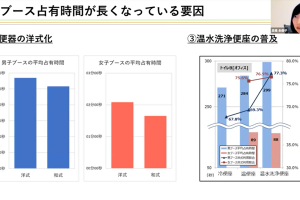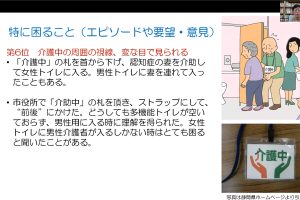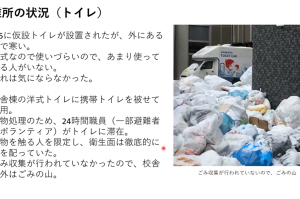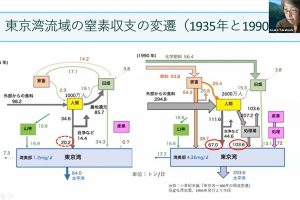Title: The 3rd seminar “Home and Shelter Toilet Condition in Emergency”
Date: 17 June 2021 (Thu) 18:00-20:00 JST
Presenters:
Mr. Kan-ichi Adachi,
CEO of Excelsior Co., Ltd.
Deputy Coordinator of Disaster, Temporary Toilet (DTT) Study Group in JTA,
Work Group Leader of Portable & Concise Toilet.
Mr. Wataru Tanimoto
Hino Kogyo Co., Ltd.
Deputy Coordinator of DTT Study Group in JTA,
Work Group Leader of Temporary Toilet at the Shelter.
Chairperson: Prof. Dr. Yoshihiko Kawauchi,
Director of Japan Toilet Association
Prof. Emeritus of Toyo University.
Part 1, Do you prepare a portable & concise toilet for a disaster?
“The portable & concise toilet” may be also called “The disposal vinyl bag toilet.” It is said there are 80% possibilities of a next big earthquake within 30 years in Japan. Then the toilet cannot be used during the sewer pipe breaks.
<Actual condition of stockpiling>
Normally humans go to the toilet about five times a day for the excrement. In case of three family members, the bathtub will be completely filled up in a month. It is said a flush toilet cannot be used for several months when the sewage process plant is broken. It is a nightmare to suppose the pile of accumulated excrement is left unattached at home.
Disaster, Temporary Toilet (DTT) Study Group surveyed this matter by questionnaires on the Internet during 2017 to 2020. The stockpile of portable & concise toilets for disasters at home increased slightly from 2017 to 2020. As elevators must stop in tower condominiums, stockpiling of the emergency supplies is especially necessary. The emergency foods are already stockpiled by 47.6%, however portable & concise toilets are only about 20%.
The average amount of the portable & concise toilets in stock is prepared for 25.3 times uses in 2020, however considering the excretion is five to seven times per a day and the sewerage will be restored on a monthly later, and more numbers of portable & concise toilets must be required in practice. 14% respondents said they had an experience to have used the portable & concise toilet. About 60% of them read the toilet manual. About 30% of them have never read the manual. When time permits, please try to use it in advance.
It is important to prepare a portable & concise toilet that can be used soon after a disaster, because government cannot afford to take care for the toilet facilities immediately after it.
19.5% of respondents already have stockpiles. 33.8% are planning, 17.8% are not planning. 28.9% are indecisive. At the disaster, a great deal of flush toilets cannot use and the support will not come straight away. Therefore it is important for everyone to recognize that the stockpile of portable & concise toilets is essential.
Part 2, Suppose a situation of the temporary toilets use in the shelter at disaster
Disaster toilets are portable toilets, concise toilets, manhole toilets, and temporary toilets. The temporary toilets must be delivered three days after of the disaster at fastest and then enough number of temporary toilets for the shelters will take more time.
<The reasons why not delivered it immediately>
(Reason 1)
Usually there occurs the road disruption, turmoil in social conditions and sometimes difficulty to get the enough amount of the fuel. Private trucks are generally used for transportation of the temporary toilets. Even the minimum required information such as traffic conditions and the required goods number must be limited.
In the case of Kumamoto earthquakes in April 2016, there was a request from Ministry of Economy, Trade and Industry (METI) to ship all in sit-style toilets. The heavy flood in Kumamoto in July 2020 was the first experience that the accessible toilets were installed. Temporary toilets are usually installed at events square and construction sites however the accessible toilets are currently only 0.1% in the total stockpiles.
(Reason 2)
There are five to six main manufacturers of temporary toilets in Japan in Shizuoka. Another one company is in Okayama. It takes at least two days to transport from there to the necessary location if more than 500 kilometers away. Moreover there are problems of the shortages of the long-distance drivers.
(Reason 3)
The freight trucks with a flat body type to carry large temporary toilets are decreasing to be left only 20%. The first shipment of temporary toilets will be from the surplus inventory in the rental company. The crouching-style toilet is an old toilet bowl in Japan and they are left more than sit-style ones, but crouching-style toilets are unpopular now. There are 74% crouching style and 26% sit-style for temporary toilets. Ministry of Land, Infrastructure, Transport and Tourism (MLIT) is promoting on sit-style toilets to be called “Comfortable Toilet.” Following to this movement, local governments are widely budgeting to increase the comfortable toilets.
<Measures to install the temporary toilets>
(Installation Measure 1)
It is important to decide where to install the temporary toilet facilities in advance. From the viewpoint of hygiene and crime prevention, it is desirable that women will participate at the placement planning. It is also necessary to consider the place where a vacuum pump cleaning car can approach. In the case of the school, the passageway is often an obstacle.
(Installation measure 2) Appropriate management is essential.
The users must cooperate to clean the toilets. Please refer to a manual by the National Building Maintenance Association about equipment, chemicals and methods. Without an assignment of cleaning on duty, the temporary toilet can get dirty very quickly.
(Installation measure 3) It is necessary to consider the toilet environment issues.
The first issue is the odor and insect control. Especially it gets worse in the summer season and it is necessary to use appropriate drugs. Next issue is to secure lighting, since there is often insufficient lighting in the temporary toilets or without the electric supply. Moreover it cannot be used without the supply water and pumping.
<Agreement for the Disaster>
In recent years, many local governments signed agreements for disaster with the manufacturers and rental companies for the temporary toilets. However please do not conclude and feel relieved simply with the agreement. It is important to actually hold disaster prevention drills and seminars and then keep them in practice.
The percentages among self-help, community assistance and public assistance will be 70%: 20%: 10% respectively. The first step is self-help to endure at least three to seven days with surpassing the stockpile of the portable toilets in home. Community assistance is collaboration by training by local governments, neighborhoods, associations and in evacuation shelters. Public assistance is the national and local governments will make agreements for the disaster and conduct thorough rehearsals beforehand.
Depending on the level of the disaster, the percentages among of them will change.
<Q&A>
Adachi: Most of the advanced disaster prevention products are Japanese made. Overseas products are mainly for mountain climbing and campsites and most of them are to consolidate with a coagulant or used as a deodorant bag.
Tanimoto: DTT Study Group survey report on disaster toilet stockpiling in 2020 linked home page of JTA and it is also posted at the website of the Disaster & Temporary Toilet Study Group.
Tanimoto: There are AP’s of smartphones to find accessible toilets on the map. Regarding temporary toilets at a disaster, some local governments list them in the form of planned locations on the website. In addition, such information can disseminate by the local people, for instance by SNS service. Attaching locational information equipment to the temporary toilet is currently unlikely because of the cost issue. The day will come when the size becomes smaller without batteries, then it can be possible to develop such a map synchronizing with the inventory toilet management.
Tanimoto: There does not yet enact a design standard or Japanese Industrial Standard (JIS) standard for temporary accessible toilets. Nevertheless new types of accessible toilets are still developing individually.
Adachi: All manufacturers define stockpile deadline for portable & concise toilets by the aging of the film that encloses the coagulant. However unlikely food preservation, there will be no problem to use even if the stockpile is expired.
Adachi: Ministry of the Environment (MOE) informs that the disposals after use are incineration waste. Consequently local government will decide depends on the capacity and age of the incinerator. There are not common rules among local governments yet.










